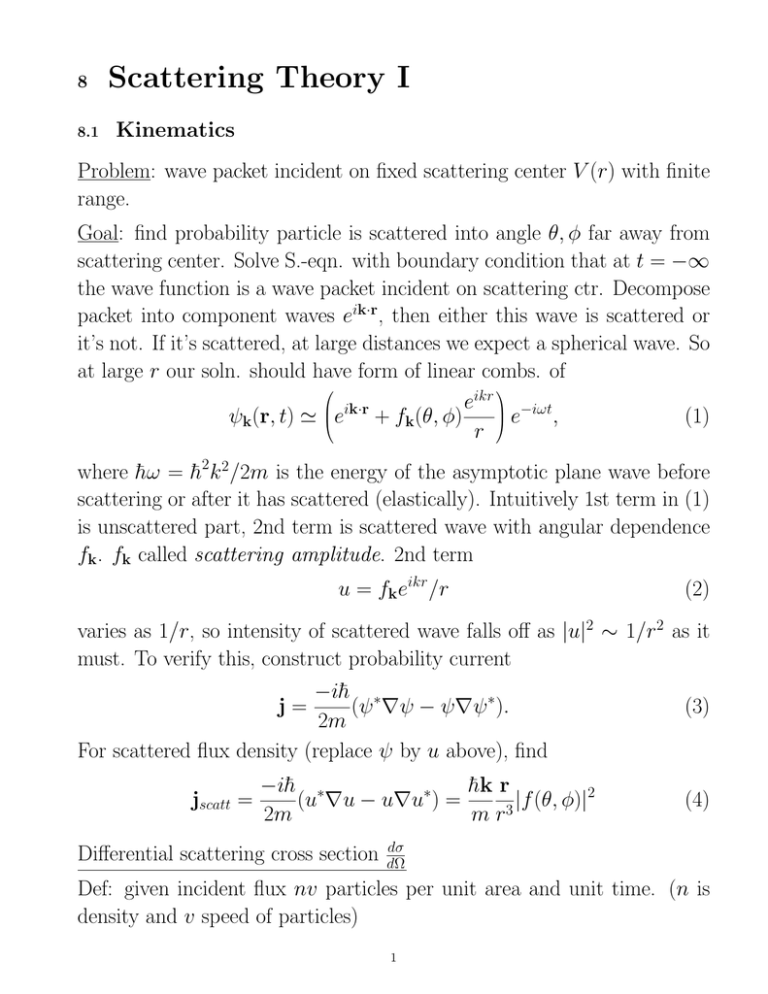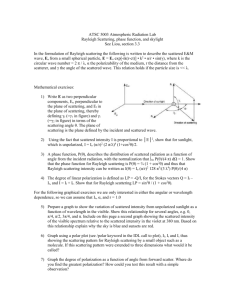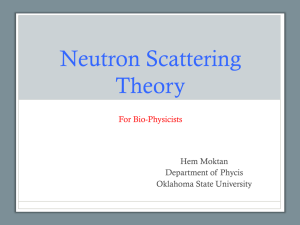Scattering Theory I
advertisement

8
8.1
Scattering Theory I
Kinematics
Problem: wave packet incident on fixed scattering center V (r) with finite
range.
Goal: find probability particle is scattered into angle θ, φ far away from
scattering center. Solve S.-eqn. with boundary condition that at t = −∞
the wave function is a wave packet incident on scattering ctr. Decompose
packet into component waves eik·r, then either this wave is scattered or
it’s not. If it’s scattered, at large distances we expect a spherical wave. So
at large r our soln. should have form of linear combs. of
ikr
e
−iωt
ik·r
e
e
ψk(r, t) '
+ fk(θ, φ)
,
(1)
r
where h̄ω = h̄2k 2/2m is the energy of the asymptotic plane wave before
scattering or after it has scattered (elastically). Intuitively 1st term in (1)
is unscattered part, 2nd term is scattered wave with angular dependence
fk. fk called scattering amplitude. 2nd term
u = fkeikr /r
(2)
varies as 1/r, so intensity of scattered wave falls off as |u|2 ∼ 1/r2 as it
must. To verify this, construct probability current
−ih̄ ∗
(ψ ∇ψ − ψ∇ψ ∗).
2m
For scattered flux density (replace ψ by u above), find
j=
jscatt =
−ih̄ ∗
h̄k r
2
|f
(θ,
φ)|
(u ∇u − u∇u∗) =
2m
m r3
Differential scattering cross section
(3)
(4)
dσ
dΩ
Def: given incident flux nv particles per unit area and unit time. (n is
density and v speed of particles)
1
Particles collected in detector of area A at angles θ, φ from incident direction. A therefore subtends δΩ = A/r2 steradians. Recall classically
dN
dσ
= (nv) ·
· δΩ
dt
dΩ
differential
rate of detecting
incident
subtended
=
· scattering ·
particles in A
flux density
solid angle
cross sec.
From eq. (4) above, have
dN
h̄k r
h̄k dσ A
2
= jscattA =
|f
(θ,
φ)|
A
=
·
·
dt
m r3
m dΩ r2
so
dσ
(θ, φ) = |f (θ, φ)|2
dΩ
Total scattering cross-section σ
Total cross-section defined by integrating over all angles:
Z
dσ Z
σ = dΩ
= dΩ|f (θ, φ)|2
dΩ
Reminder–classical analog & origin of name “cross-section”:
(5)
(6)
(7)
(8)
(9)
Consider n pt. particles/vol. incident on sphere, radius a, flux nv. Particle
scatters if its impact parameter is less than a, so net scattered flux is
nv · πr2, total σ = πa2.
2
8.2
Optical theorem
A conservation law–relates diminished amplitude of unscattered beam to
flux scattered out of beam.
Incident flux density in Fourier component eikz of incident beam is
h̄k
(10)
vclassical =
m
Role of classical density of particles n played by |ψbeam|2 = 1. From (9)
net scattering rate is
h̄k Z
nvσ =
dΩ|fk |2
(11)
m
so outgoing unscattered beam must be diminished by this amount. “Outgoing” means eikz plus forward scattering part of scattered wave,
f (0) ikr
e
(12)
ψ = eikz +
r
For angles close to forward scattering,
2
√
x
r = z 2 + x2 ' z +
(13)
2z
so at large z,1
2
kx
f (0) i
1 +
ψ ∼ eikz
e 2z
(14)
z
Now want to compute probability flux in forward direction. Rapidly varying part of (14) is eikz , so
∇ψ ' ikψ ẑ
f ∗(0) −i
f (0) i
ψ ∇ψ ' ikψ ψ = ik 1 +
e 2z 1 +
e 2z
z
z
2
kx
2
1 +
' ik
Re f (0)ei 2z
z
∗
1 Peebles
∗
kx2
kx2
calls this ψf for forward, but I’m too lazy, so you have to remember I’m always talking about small angles
3
(15)
(16)
(17)
So to lowest order flux density in forward direction is
ih̄ ∗
(ψ ∇ψ − c.c.)
2m
kx2
h̄k
2
1 +
'
Re f (0)ei 2z
m
z
j = −
(18)
(19)
The first term is the same as the incident flux density, the second is the
reduction of the outgoing flux by forward scattering. If we go out far
enough along z, even for small angles the x can get large, so we need to
integrate all the scattered flux (2nd term) in the forward direction:2
ikx2
2
2z
= −vcl
2πxdx
Re
f
(0)e
0
by forward scattering
z
2
2z
see footnote → = vcl π
Imf (0)
≡ vcl σ
z
k
Z ∞
reduction of flux
(21)
(22)
since vσ is the definition of the total flux removed from the beam by
scattering! So
σ=
4π
k Imf (0)
“Optical theorem”
(23)
Interpretation:
Incident plane wave brings in probability current density in z direction.
Some of it gets scattered into various directions. Must give rise to decrease
in current density behind target (θ = 0) due to destructive interference
of incident plane wave and scattered wave in forward direction. So total
flux scattered (vσ) related to forward scattering amplitude f (0).
2 This is a mathematically very ill-defined procedure, and you shouldn’t believe it until you see we get the same result by phase shift
analysis later. But the integration goes as follows:
Z
∞
ikx2 /(2z)
2xdx e
0
2z
=
ik
Z
i∞
du eu = −
0
2iz u i∞
e |0
k
(20)
We now want to argue that we can neglect the exponential at its upper limit because it is rapidly oscillating, i.e. we want to be able to
set ei∞ → 0. Peebles argues physically: that a real beam will consist of a finite spread of incident directions and cut off the increase in
the rate of oscillations as z → ∞. That the oscillations at ∞ then average out to zero is guaranteed by the Riemann-Lesbegue lemma3 .
4
8.3
Born approximation.
Valid for weak scattering or fast particles!
Want to solve S.’s eqn for scattering potential V (r) with boundary condition
eikr
ik·r
ψ →e +f
(24)
r
for suff. large r. We’re looking first for solutions with
h̄2k 2
E=
“scattering states”
(25)
2m
i.e., not bound states where the particle is trapped by the target. So
S.-eqn. looks like
2mV
∇2ψ + k 2ψ = 2 ψ ≡ ²U ψ
(26)
h̄
Now seek power series expansion of ψ (in powers of scattering potential):
ψ(r) = eik·r + ²ψ (1) + ²2ψ 2 + . . .
(27)
plugging into (26) gives
²(∇2ψ (1) + k 2ψ (1)) + ²2(∇2ψ (2) + k 2ψ (2)) =
= ²U eik·r + ²2U ψ (1) + . . .
(28)
as usual equate powers of ²:
∇2ψ (1) + k 2ψ (1) = U eik·r
∇2ψ (2) + k 2ψ (2) = U ψ (1),
...
etc.
(29)
(30)
(31)
See that we get sequence of coupled eqns., each coupled to previous one
on rhs. This is called Born’s series.
If we want to solve to linear order in ², take only (29). Solve by Fourier
transform; and define
5
Z
ψk =
and the inverse
ψ (1)(r)e−ik·rd3r
Z
(1)
ψ (r) =
ψke
ik·r
d3 k
(2π)3
(32)
(33)
0
So multiply (29) by e−ik ·r and integrate lhs by parts4 to get
2
(k 2 − k 0 )ψk0 =
Z
0
U (r)ei(k−k )·rd3r
(35)
which yields immediately
0
1 Z 3 0 eik ·r Z 3 0
0 i(k−k0 )·r0
ψ (r) =
d
k
d
r
U
(r
)e
(2π)3
k2 − k02
ik0 ·(r−r0 )
Z
1 Z 3 0
0 ik·r0
3 0e
d r U (r )e
dk 2
=
02
(2π)3
k
−
k
|
{z
}
(1)
(36)
(37)
I(r − r0)
Now we spend some tedious but hopefully useful time showing how to
calculate integrals of this type.
First evaluate I(r − r0 ). Use polar coords., polar axis along y ≡ r − r0 , θ is angle between y and k0 :
k0 · y = k 0 y cos θ
3 0
dk
02
(38)
0
= k dk sin θdθdφ.
(39)
So angular part of I is
Z 2π
0
dφ
Z π
0
sin θdθ e
ik0 y cos θ
= 2π
Z 1
−1
0
d cos θeik y cos θ
sin k 0 y
= 4π 0
ky
so left with
I = 4π
Z ∞
k 0 2 dk 0 sin k 0 y
0
k2 − k02 k0y
(40)
(41)
(42)
Trick: note integrand is even in k 0 , write I as
I =
4 Explicitly,
use
0
2π Z ∞ k 0 dk 0 eik y
i ∞ k2 − k02 y
because cos part odd in k 0 ,
therefore doesn’t contribute
(43)
Z
0
(∇2 ψ(r))e−ik
·r 3
6
2
d r = −k0 ψk0
(34)
This is an improper integral due to the singularity at k = ±k 0 . However we use physics to regularize:
so far we haven’t used condition that we want w. fctn. ψ at ∞ to look like scattered wave. This
corresponds in integral scattering formulation to specifying contour for I in complex plane. One
possibility is to handle singularities by following contour shown below.
Use Cauchy integral formula,5 complete the contour in upper half-plane, shrink the contour to the
pole at +k, to get:
I =
iky
2π eiky 1 I dk 0
2e
·
=
−2π
i y 2 | k{z− k}0
y
− 2πi
(45)
(46)
This procedure may seem rather arbitrary at 1st sight, but a look at other choices suggests it’s right
thing to do. If we take contour above both poles, get zero! If we take contour opposite to figure
(above k and below −k) or below both poles, get a contribution I ∝ e−iky . Recall y = |r − r0 ; if r
is in asymptotic region, r À r0 , I ∝ e−ikr , which is ingoing, not outgoing scattered wave. So choice
of contour effectively implements boundary condition.
Continuing, find
ik|r−r0 |
1 Z 3 0
0 ik·r0 e
ψ (r) = −
d r U (r )e
4π
|r − r0 |
(1)
(47)
Finally, look at ψ in asymptotic region, r À r0 : use
|r − r0 | ' r + r̂ · r0
0
eik|r−r |
1 ikr −ikr̂·r0
|
'
e e
|r − r0 |
r
define ks ≡ kr̂
to write
1
ψ (r) ' −
4π
µZ
(1)
5 If
3 0
0
d r U (r )e
i(k−ks )·r0
(48)
(49)
(50)
¶ ikr
e
r
(51)
you don’t like the integral formula, note this choice is equivalent to replacing (29) by
∇2 ψ (1) + (k2 + i²k)ψ (1) = U eik·r
i.e. shifting the zeros of the integrand of I to
k0
= ±(k + i²/2).
7
(44)
Now can compare directly to Eq. (1), to identify (use U = 2mV /h̄2).
0
R
m
3 0
0 i(k−ks )·r
f (θ, φ) = − 2πh̄
2 d r V (r )e
(52)
k along incident direction
ks along scattered direction
This is Born approximation. Diff. scatt. cross sec. will be dσ/dΩ = |f |2.
Low-energy limit
We consider only elastic scattering, Ef = Ei = h̄2k 2/2m. 6 Note main
contribution to integral in (53) is from r0’s inside range of scattering potential r0 (meaning V (r0) small for |r0| À r0.) Thus if we consider low-energy
scattering such that kr0 ¿ 1, argument of exponential in (53) is ' 1, so
find immediately
dσ/dΩ '
³
m2 R
4π 2 h̄4
´2
d3r0V (r0) ,
kr0 ¿ 1
(53)
Isotropic!
8.4
Screened Coulomb scattering
Scattering by bare Coulomb potential very singular, not obvious we can
treat it properly with formalism introduced here (V (r) was assumed to
have finite range). However we’ll treat a screened Coulomb or Yukawa7
potential,
−αr
2 e
V (r) = −e
(54)
r
which has range 1/α, and show that in limit α → 0 we indeed recover
Rutherford differential cross section for Coulomb scattering.
Born approx. for Yukawa potential.
6 So
in scattering process direction changes from k to ks , but momentum magnitude h̄k doesn’t change.
wrote it down as a phenomenological model for the strong force in nuclei to explain p − p scattering experiments, and was led
to propose the existence of the pion as a mediating particle. The form is also characteristic of the Coulomb interaction between charges
in a charged medium capable of screening, hence the title of this section. It’s not a bad model for atomic scattering, since a fast electron
penetrating the electronic cloud surrounding the nucleus sees more and more charge the closer it gets.
7 Yukawa
8
Define q = k − ks. Work here is only in calculating integral
I ≡
=
Z
Z
Z
e−iq·r−αr
dr
rZ
−αr
dr re
dΩe−iq·r
3
dr re−αr · −i2π(eiqr − e−iqr )/qr
4π
1
4π
=
Im
= 2
q
α − iq α + q 2
=
(55)
(56)
(57)
(58)
So diff. scatt. cross section is
m2
dσ/dΩ ' 2 4 I
4π h̄
4m2e4
=
h̄4(α2 + q 2)2
2 4
→ 4m e
α→0
q 4h̄4
e4
=
4m2v 4 sin4(θ/2)
(59)
(60)
(61)
where v = h̄k/m is classical velocity, and we used geometry to relate
momentum transfer q to incoming momentum k, q = 2k sin θ/2, as seen
from picture.
Eq. 62 is in fact famous Rutherford formula for Coulomb scattering
so we did get “right” answer after all. Note great irony here: classical
result obtained correctly using leading-order Born approximation, so h̄
doesn’t play major role! Yet measurement of Rutherford cross-section
proved existence of pointlike nucleus, and it was problem of stable orbits
around nucleus which led to Bohr’s quantum mechanics!
9








